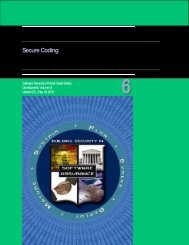Architecture and Design Considerations - Build Security In - US-CERT
Architecture and Design Considerations - Build Security In - US-CERT
Architecture and Design Considerations - Build Security In - US-CERT
Create successful ePaper yourself
Turn your PDF publications into a flip-book with our unique Google optimized e-Paper software.
2. The Secure <strong>Build</strong>er Factory pattern implementation uses the given security credentials to select <strong>and</strong> return the<br />
appropriate object implementing the <strong>Build</strong>er pattern. The <strong>Build</strong>er pattern’s intent is to abstract the steps of constructing<br />
an object so that difference implementations of these steps can construct difference representations of objects. The<br />
selected object will then be used to correctly build a complex object given the security rules identified by the given<br />
security credentials.<br />
Secure Supply Chain of Responsibility – The intent of this pattern is to decouple the logic that determines user/environmenttrust<br />
dependent functionality from the portion of the application requesting the functionality, simplify the logic that determines<br />
user/environment-trust dependent functionality, <strong>and</strong> makes it relatively easy to dynamically change the user/environment-trusted<br />
dependent functionality.<br />
Secure State Machine – The intent of the Secure State Machine pattern is to allow a clear separation between security<br />
mechanisms <strong>and</strong> user-level functionality. This is achieved by implementing the security <strong>and</strong> user-level functionality as two<br />
separate state machines. This pattern is applicable if:<br />
» The user-level functionality can be cleanly represented as a finite state machine, or<br />
» The access control model for the state transition operations in the user-level functionality state machine can also be<br />
represented as a state machine.<br />
When developing state machines, CWE-642 “External Control of Critical State Data” provides the following mitigation techniques:<br />
» Use a framework that maintains the state automatically with a stateless protocol, such as HTTP. Examples include<br />
ASP.NET View State <strong>and</strong> the OWASP ESAPI Session Management feature. Be careful of language features that<br />
provide state support, since these might be provided as a convenience to the programmer <strong>and</strong> may not be considering<br />
security.<br />
» Don’t keep state information on the client without using encryption or integrity checking, or otherwise having a<br />
mechanism on the server-side to catch state tampering. When storing state information on the client use a message<br />
authentication code (MAC) algorithm, such as Hash Message Authentication Code (HMAC), provide an algorithm with<br />
a strong hash function, <strong>and</strong> salt the hash. Provide mutable classes with a clone method.<br />
» Don’t allow any application user to affect state directly in any way other than through legitimate actions leading to state<br />
transitions.<br />
Additional information on CWE-642 “External Control of Critical State Data” can be found in the Key Practices for Mitigating the<br />
Most Egregious Exploitable Software Weaknesses pocket guide.<br />
Secure Visitor – Secure systems may need to perform various operations on hierarchically structured data where each node in<br />
the data hierarchy may have different access restrictions; that is, access to data in different nodes may be dependent on the<br />
role/credentials of the user accessing the data. The Secure Visitor pattern allows nodes to lock themselves against being read<br />
by a visitor unless the visitor supplies the proper credentials to unlock the node. Once the Secure Visitor is defined, the only way<br />
to access a locked node is with a Visitor, this helps prevent unauthorized access to nodes in the data structure. A Visitor is a<br />
class with methods that require unlocked node objects. The Secure Visitor pattern is applicable if, among other things, the<br />
system nodes in the hierarchical data have different access privileges. For more information on Secure Visitor, please visit the<br />
Secure <strong>Design</strong> Patterns technical report at www.cert.org/archive/pdf/09tr010.pdf.<br />
Resources<br />
» “Secure <strong>Design</strong> Patterns.” Chad Dougherty, Kirk Sayer, Robert Seacord, David Svoboda, <strong>and</strong> Kazuya<br />
Togashi, Software Engineering <strong>In</strong>stitute, October 2009. .<br />
» “Software <strong>Security</strong> Assurance: A State-of-the-Art Report” (SOAR). Goertzel, Karen Mercedes, et al.,<br />
<strong>In</strong>formation Assurance Technology Analysis Center (IATAC) of the DTIC, 31 July 2007.<br />
.<br />
<strong>Architecture</strong> <strong>and</strong> <strong>Design</strong> <strong>Considerations</strong> for Secure Software 16
















